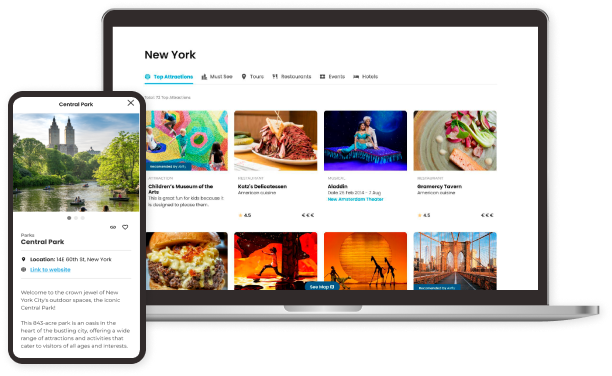In the travel industry, where each season can redefine travelers’ favorite destinations, anticipating change is no longer a luxury — it’s a strategic necessity. With the rise of artificial intelligence (AI), travel brands now have the ability not only to observe what’s happening today but also to gain a clearer view of what’s coming next.
Predictive analysis, powered by AI technologies, allows companies to detect emerging destinations, forecast traveler behavior, and create optimized content just before demand peaks. This article explores how to leverage these techniques to get ahead of the competition, incorporating seasonal and niche keywords to capture the attention of the new generation of digital travelers.
What Is Predictive Analysis in Tourism?
Predictive analysis uses current and historical data to forecast future behavior. In tourism, it helps identify travel patterns, shifts in preferences, and emerging interest in specific destinations or types of experiences.
Imagine knowing weeks in advance that a small coastal town in Portugal will gain attention due to a Netflix reality show. Or that a spike in TikTok searches for “hidden thermal baths in Europe” could turn rural areas of Slovenia into trending tourist spots. Predictive analysis allows you to spot these weak signals and act before they become mainstream trends.
Anticipating Emerging Destinations with AI
Forward-thinking travel brands no longer rely solely on annual market studies or creative hunches. Thanks to AI, it’s now possible to identify micro-trends in near real time and adapt digital content strategies dynamically.
Tools that combine search analysis, social media activity, and navigation data offer a detailed view of emerging traveler interest. When there’s a consistent rise in mentions of a destination on platforms like Instagram or TikTok, paired with growing Google searches, that place is likely about to experience a popularity surge. Anticipating this with well-crafted, SEO-optimized content can make a substantial difference.
Moreover, machine learning models can identify historical patterns that tend to repeat. For instance, whenever a major international event takes place in a city, there’s often a tourism boom in the following months. AI can detect these cycles and help you prepare content in advance.
Optimized Content Before the Competition
One of the most direct applications of predictive analysis is creating web content before users begin searching for it en masse. This is especially powerful for blogs, destination landing pages, newsletters, and digital travel guides.
The goal isn’t to write about what’s already popular, but about what’s about to become so. Instead of focusing on Rome during peak season, you could publish content about Perugia or Urbino if early indicators suggest growing cultural interest in less-crowded destinations.
This strategy requires solid editorial planning and the flexibility to update quickly. Having a technology partner or tools that allow automated content generation and updates can be crucial. In this regard, platforms like Smartvel, which use AI to enrich destination content, enable airlines, OTAs, or hotels to keep their platforms aligned with rising traveler interest.

Seasonal and Niche Keywords: Predictive SEO
SEO today is no longer just about knowing what users are searching for right now. AI enables you to predict what they’ll search for next — introducing the concept of predictive SEO, which anticipates future search trends.
Seasonal keywords are those that follow predictable annual search cycles. Phrases like “where to travel at Easter,” “cool summer destinations,” or “autumn getaways” spike at specific times. Analyzing these patterns with AI allows you to prepare content weeks or even months in advance, ensuring it’s visible when interest peaks.
On the other hand, niche keywords provide an opportunity to capture highly qualified traffic. While most competitors target broad terms like “travel to Greece,” a predictive strategy might reveal emerging searches like “lesser-known Dodecanese islands” or “quiet beaches near Athens.” These long-tail keywords tend to have lower competition and are more aligned with real user intent.
The key lies in tracking how searches evolve, identifying new combinations and synonyms, and adapting your content intelligently and ahead of time.
The Power of Data in Decision-Making
All of this is driven by data. The more structured, high-quality data you have, the more accurate your predictions will be. But it’s not just about collecting information — it’s about interpreting it effectively.
Brands that combine their own internal data (such as web navigation stats, past campaign results, or customer service queries) with external sources (like global searches, social trends, and analytics tools) have a more complete view and can react with greater agility.
For instance, if an OTA notices a sudden rise in internal searches for “solo travel in Asia” and observes a similar trend in Google data, it’s time to act. This insight could trigger the creation of specific content, the launch of a segmented campaign, or the curation of new featured travel routes.
Real-World Use Cases
These techniques are already in action. Companies like Smartvel are helping tourist destinations and large hotel groups enrich their content with predictive intelligence. Their technology allows for the automatic integration of local events, highlighted activities, or popular attractions based on seasonality and digital traveler behavior.
Airlines such as Lufthansa and Iberia are also beginning to plan digital campaigns not just by season, but based on emerging AI-detected trends, adjusting their offerings of flights, getaways, and city breaks before demand surges.
How to Get Started: Practical Steps
To implement predictive trend analysis in your content strategy, start by assessing the tools and resources you have available. Google Trends remains an excellent initial source for seasonal patterns, but to go further, explore platforms like Exploding Topics, Glimpse, or even AI tools like ChatGPT integrated with your data sources.
From there, establish a continuous monitoring system for keywords, behaviors, and destination interest. Build a flexible editorial calendar that can adapt to change, and if possible, automate parts of your content production using scalable technologies.
Most importantly, shift your mindset. It’s no longer about reacting to what’s already happening — it’s about positioning yourself ahead of time. In the highly competitive world of digital tourism, those who arrive first with the right content earn the traveler’s trust — and their booking.

Predictive analysis powered by AI is transforming how travel brands understand and anticipate traveler desires. Following trends is no longer enough — now it’s possible to get ahead of them.
With a strategic approach backed by data and intelligent tools, you can create relevant content at just the right moment. Not only does this improve SEO performance, but it also fosters a more authentic connection with users, who feel that someone has anticipated their journey — even before they start planning it.
Are you ready to stay ahead of the future of tourism?






